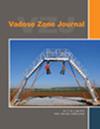瞬态两相流过程中动态毛细管对砂土剪切强度的影响:非平衡三轴模拟的启示
IF 2.8
3区 地球科学
Q3 ENVIRONMENTAL SCIENCES
引用次数: 0
摘要
非饱和多孔介质中的两相流动建模不仅对暗影带水文学非常重要,而且在不同学科中也具有重要价值。常见的方法是使用流体压差与饱和度之间的简化关系,忽略饱和度变化率的影响。然而,许多研究表明,这种方法的适用性仅限于饱和度变化率不明显的情况。尽管多项研究强调了非平衡毛细管效应在非饱和流动建模中的重要性,但其在多孔介质力学响应中的意义仍不明确。因此,本研究旨在通过比较传统静态方法和包含动态毛细管效应的先进方法的模拟结果来弥补这一不足。比较在不同的流动边界条件下进行,以评估两种方法之间的差异程度。结果表明,随着水力边界条件绝对值的增加,两种模拟方案(动态和静态)的机械响应之间的对比变得更加明显。例如,动态模型预测的剪切强度比静态模型高出 50%。这突出了在模拟非饱和多孔介质力学行为时考虑非平衡效应的重要性。最后,对动态系数、空气进入值和饱和传导率的影响进行的参数研究表明,动态系数对力学响应的影响更为明显。本文章由计算机程序翻译,如有差异,请以英文原文为准。
Effects of dynamic capillarity on the shear strength of sandy soils during transient two‐phase flow: Insights from non‐equilibrium triaxial simulations
Modeling two‐phase flow in unsaturated porous media is not only important to vadose zone hydrology but also of great value in diverse disciplines. Common approaches use a simplified relationship between fluid pressure difference and saturation, neglecting the influence of saturation change rates. However, many studies have suggested that the applicability of this approach is limited to situations where the rate of change in saturation is insignificant. Despite several studies highlighting the importance of non‐equilibrium capillarity effects in unsaturated flow modeling, its significance in the mechanical response of the porous medium remains unclear. This study thus aims to address this gap by comparing the simulation results of the traditional static approach and an advanced approach that incorporates dynamic capillarity effects. The comparison is conducted under various flow boundary conditions to assess the magnitude of the differences between the two approaches. The results indicate that as the hydraulic boundary conditions’ absolute values increase, the contrast between the mechanical response of the two simulation scenarios (dynamic and static) becomes more significant. For instance, the dynamic model can predict shear strengths up to 50% higher than the static model. This highlights the importance of considering non‐equilibrium effects while modeling the mechanical behavior of an unsaturated porous medium. Finally, the parametric study of the effect of dynamic coefficient, air entry value, and saturated conductivity reveals the more pronounced effect of the dynamic coefficient on the mechanical response.
求助全文
通过发布文献求助,成功后即可免费获取论文全文。
去求助
来源期刊

Vadose Zone Journal
环境科学-环境科学
CiteScore
5.60
自引率
7.10%
发文量
61
审稿时长
3.8 months
期刊介绍:
Vadose Zone Journal is a unique publication outlet for interdisciplinary research and assessment of the vadose zone, the portion of the Critical Zone that comprises the Earth’s critical living surface down to groundwater. It is a peer-reviewed, international journal publishing reviews, original research, and special sections across a wide range of disciplines. Vadose Zone Journal reports fundamental and applied research from disciplinary and multidisciplinary investigations, including assessment and policy analyses, of the mostly unsaturated zone between the soil surface and the groundwater table. The goal is to disseminate information to facilitate science-based decision-making and sustainable management of the vadose zone. Examples of topic areas suitable for VZJ are variably saturated fluid flow, heat and solute transport in granular and fractured media, flow processes in the capillary fringe at or near the water table, water table management, regional and global climate change impacts on the vadose zone, carbon sequestration, design and performance of waste disposal facilities, long-term stewardship of contaminated sites in the vadose zone, biogeochemical transformation processes, microbial processes in shallow and deep formations, bioremediation, and the fate and transport of radionuclides, inorganic and organic chemicals, colloids, viruses, and microorganisms. Articles in VZJ also address yet-to-be-resolved issues, such as how to quantify heterogeneity of subsurface processes and properties, and how to couple physical, chemical, and biological processes across a range of spatial scales from the molecular to the global.
 求助内容:
求助内容: 应助结果提醒方式:
应助结果提醒方式:


